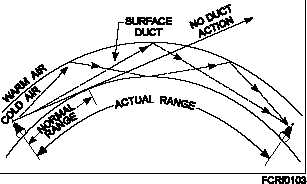Range Resolution
Range resolution is the ability of a radar to
distinguish between two targets on the same bearing,
but at slightly different ranges. The degree of range
resolution depends on the width of the transmitted
pulse, the types and sizes of the targets, and the
efficiency of the receiver and the indicator.
Bearing Resolution
Bearing, or azimuth, resolution is the ability of a
radar system to separate objects at the same range, but
at slightly different bearings. The degree of bearing
resolution depends on the radar’s beamwidth and the
range of the targets. The physical size and shape of the
antenna determines beamwidth.
Two targets at the
same range must be separated by at least one
beamwidth to be distinguished as two objects.
Atmospheric Conditions
Several conditions within the atmosphere can have
an adverse effect on radar performance. A few of these
are temperature inversion, moisture lapse, water
droplets, and dust particles.
The temperature and moisture content of the
atmosphere normally decrease uniformly with an
increase in altitude. However, under certain conditions
the temperature may first increase with height and then
begin to decrease.
Such a situation is called a
temperature inversion.
An even more important
deviation from normal may exist over the ocean. Since
the atmosphere close to the surface over large bodies of
water may contain more than a normal amount of
moisture, the moisture content may decrease more
rapidly at heights just above the sea. This effect is
referred to as moisture lapse.
Either temperature inversion or moisture lapse,
alone or in combination, can cause a large change in the
refraction index of the lowest few-hundred feet of the
atmosphere. The result is a greater bending of the radar
waves passing through the abnormal condition. This
increase in bending, referred to as ducting, may greatly
affect radar performance. The radar horizon may be
extended or reduced, depending on the direction in
which the radar waves are bent. The effect of ducting is
illustrated in figure 1-3.
Water droplets and dust particles diffuse radar
energy through absorption, reflection, and scattering.
This leaves less energy to strike the target, so the return
echo is smaller. The overall effect is a reduction in
usable range. Usable range varies widely with such
weather conditions. The higher the frequency of the
radar system, the more it is affected by weather
conditions, such as rain or clouds.
Other Factors
Some other factors that affect radar performance
are operator skill; size, composition, angle, and
altitude of the target; possible Electronic Attack (EA)
activity; readiness of equipment (completed planned
maintenance system requirements); and weather
conditions.
Q1. For radar surface angular measurements, what
is considered to be at the center of the coordinate
system?
Q2. What determines radar bearing?
Q3. What is the most common method of radar
transmission?
Q4. What two factors determine radar accuracy?
BASIC RADAR SYSTEMS
Radar systems, like other complex electronics
systems, are composed of several major subsystems
and many individual circuits. Although modern radar
systems are quite complicated, you can easily
understand their operation by using a basic block
diagram of a pulse-radar system.
FUNDAMENTAL (PULSE) RADAR SYSTEM
Since most radars used today are some variation of
the pulse-radar system, this section discusses
components used in a pulse radar. All other types of
radars use some variation of these units. Refer to the
block diagram in figure 1-4.
1-5
Figure 1-3.—Ducting effect on the radar wave.

